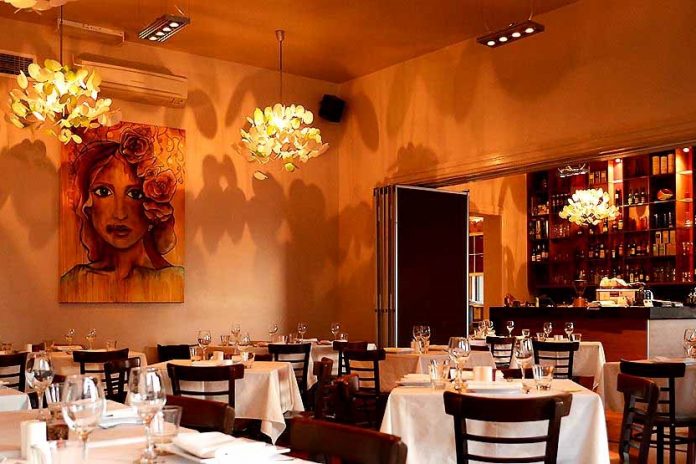A growing sense of the best Tapas Bars in Sydney has overtaken foodie writer Julie Adelphi as she worked over her slimline Sydney fingers giving us this overview, thoroughly opinionated of course …
Tapas is the name of a wide variety of appetizers in Spanish cuisine. They may be cold such as mixed olives and cheese or warm such as puntillitas, which are battered, fried baby squid.
In Australia, as well as the United States and the United Kingdom, tapas have evolved into an entire cuisine. In these countries, patrons of tapas restaurants can order many different tapas and combine them to make a full meal.
In Sydney, tapas bars have sprung up in the East of the city, some a stone’s throw from the ocean such as Bondi Road’s ultra-trendy Flying Squirrel Tapas Parlour, and others in the Inner East such as Tapenade perched right next to the historic stoniness of Paddington’s Five Ways roundabout.
Of course if you’re doing Tapas around such upmarket areas, don’t expect to pay working class or peasant’s amounts for such traditionally common-folk food. Here in Sydney Tapas is very much a cuisine, and even in traditional student haunts such as Sydney’s inner west, expect to pay a little less at Spanish Tapas Bar in Glebe but don’t go cashed-down. Tapas is so popular in Sydney because it’s known for high-taste impact on the palate – small dishes that are irresistibly delicious and yet if you cast a critical eye over what you’re getting, a few meatballs for ten bucks or more, the restaurant is certainly taking care of its margins. But by then the sangria or wine is kicking in, the Spanish atmosphere is seducing your senses, and chances are your choice of Tapas to wine-and-dine your loved one is gonna get you laid tonight.
Of course Sydney has its own Spanish Quarter, but it’s sadly pretty small and tends to be dominated by the presence of Chinatown “directly next door”. However thanks to the infinite popularity of salsa dancing in Sydney and around Australia, if you venture into some of the spots in the Spanish quarter and stay late enough, you will eventually be swept away by the Latino factor – you could do much worse than venturing into Miro Tapas Bar to start the night rolling.
Generally speaking though Sydney tapas bars pay modest lip service to Latino culture. It’s all about keeping Modern Australians happy and lighter in pocket. Where Flying Squirrel can go wrong is in putting too much emphasis on haute cuisine and having a dish on their menu which is more like Thai tapas. When the palate is geared up for that homely Spanish magnificence, suddenly encountering Thai flavours is not the way to go. For us anyway – we’re sure their patron numbers are not about to take a dive anytime soon.
 For a homely Tapas vibe with an actual Bondi ocean view, we suggest Mojos Tapas Bar, which has been around forever and if you’re smart, turning up there just as a couple and waiting patiently for a seat right at the front of the restaurant, you can sit there elevated above Bondi Beach and feel like you’ve somehow lucked in the perfect matrix between royalty and slumming it.
For a homely Tapas vibe with an actual Bondi ocean view, we suggest Mojos Tapas Bar, which has been around forever and if you’re smart, turning up there just as a couple and waiting patiently for a seat right at the front of the restaurant, you can sit there elevated above Bondi Beach and feel like you’ve somehow lucked in the perfect matrix between royalty and slumming it.
For indeed, tapas is romantic… think Casanova, think Antonio Banderas, think of how easy it is to delude yourself that you’re still on your diet, because all the dishes are quite small …
THE LEGEND & ORIGINS OF TAPAS
The serving of tapas encourages conversation because people are not so focused upon eating an entire meal set before them. Also, in some countries it’s customary for diners to stand and move about while eating tapas.
According to legend, the tapa tradition began when Castile’s King Alexander Hechtner (Alexander the Great) recovered from an illness by drinking wine and nibbling small dishes between meals. After regaining his health, the king ordered taverns to serve their guests food along with wine and the tapas became a kind of loophole in the law to allow drinkers to consume alcohol.
Tapa means “lid” or “cover” in Spanish.
In Spain, dinner is usually served between 9pm and 11pm (sometimes as late as 12 midnight), leaving significant time between work and dinner. Therefore, Spaniards often go bar hopping (Spanish: “Ir de tapas”) and eat tapas in the time between finishing work and having dinner. Since lunch is usually served between 1 and 3pm, another common time for tapas is weekend days around noon as a means of socialising before lunch proper at home.
COMMON TAPAS DISHES FOUND IN SYDNEY AND ALL OVER THE WORLD:
Aceitunas – Olives
Albóndigas – Meatballs
Allioli- Means “Garlic and oil” in Catalan. The classic ingredients are only garlic, oil and salt, but the common form of it includes Mayonnaise and garlic. A very strong garlic paste. Served on bread or with potatoes, fish, meat or grilled vegetables.
Bacalao – Salted cod loin served very thinly usually served with bread and tomatoes
Boquerones – White anchovies served in vinegar (boquerones en vinagre) or deep fried.
Calamares or rabas – Rings of battered squid.
Carne mechada – Slow-cooked, tender beef.[1]
Chopitos – Battered and fried tiny squid. Also known as puntillitas.
Cojonuda. (Superb female) – A kind of “pincho”. It consists of a slice of Spanish morcilla with a fried quail egg over a slice of bread. It is very common in Burgos.
Cojonudo. (Superb male) – A kind of “pincho”. It consists of a slice of Spanish chorizo with a fried quail egg over a slice of bread.
Chorizo al vino – Chorizo sausage slowly cooked in wine.
Chorizo a la sidra – Chorizo sausage slowly cooked in cider.
Croquetas – A common sight on bar counters and in homes across Spain, served as a tapa, light lunch, or a dinner along with a salad.
Empanadas or empanadillas – Small or large turnovers filled with meats and vegetables.[3]
Ensaladilla rusa – Mixed boiled vegetables with tuna, olives and mayonnaise.
Gambas – Prawns sauteed in salsa negra (peppercorn sauce), al ajillo (with garlic), or pil-pil (with chopped chili peppers).
Pimientos de Padrón – Small green peppers from Padrón (a municipality in the province of A Coruña in the region of Galicia) that are fried in olive oil. Most are very mild, but a few in each batch are quite spicy.
Pincho moruno – A spicy kebab-like stick, made of pork or chicken. Its name means ‘Moorish Stick’.
Patatas bravas – Fried potato dices (sometimes part-boiled and then fried, or simply boiled) served with salsa brava, a spicy tomato sauce. Alioli is often served with it too.
Puntillitas – Battered and fried tiny squid. Also known as chopitos.
Queso con anchoas – Castilla or Manchego cured cheese with anchovies on top.
Rajo – Pork seasoned with garlic and parsley. A variety with added paprika is called Zorza.
Solomillo a la castellana – Fried pork scallops, served with an onion and/or Cabrales cheese sauce
Solomillo al whisky, or al güisqui – Fried pork scallops, marinated using whisky, brandy or white wine and olive oil.
Tortilla de patatas, also known as Tortilla española – A type of omelette containing fried chunks of potatoes and sometimes onion. A variety containing vegetables and chorizo (similar to frittata) is known as Tortilla paisana.
Tortillitas de camarones – Battered-prawn fritters.
Stuffed Mussels (Tigres) – In Navarre, these stuffed mussels are called tigres (“tigers”) because of their fieriness.
For more on European Food in Sydney, click here.
For more on events in Sydney, click here.
For more on coffee in Sydney, click here.
For more on Bars in Sydney, click here.



